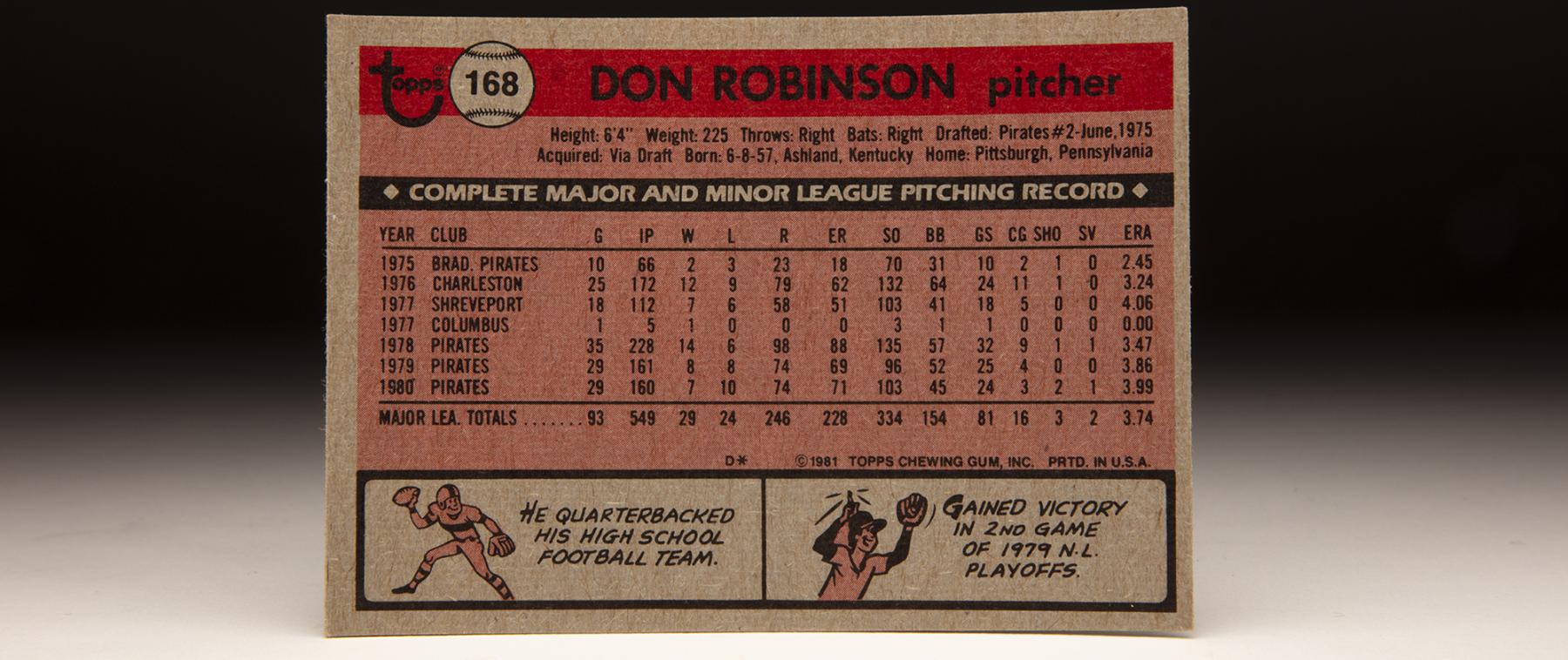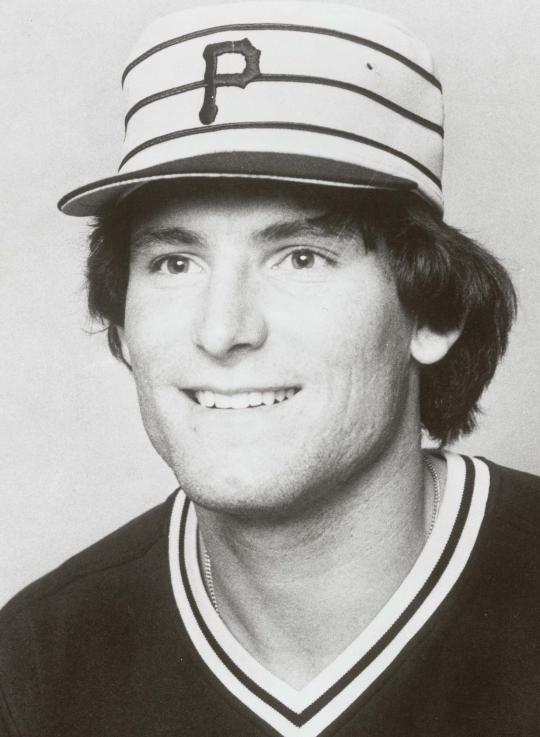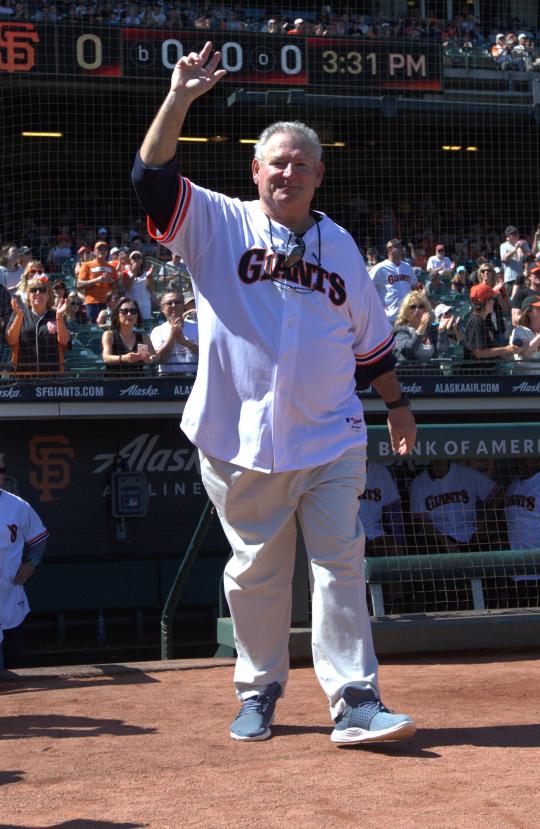- Home
- Our Stories
- #CardCorner: 1981 Topps Don Robinson
#CardCorner: 1981 Topps Don Robinson
Pirates manager Chuck Tanner had the deepest bullpen in baseball at his disposal in 1979, with Kent Tekulve, Grant Jackson and Enrique Romo combining for 28 wins and 50 saves over 250 appearances.
But when the postseason dawned after Pittsburgh held off Montreal in the National League East, Tanner decided there was room for one more late-inning reliever. And Don Robinson’s work that October just might have been the difference in the Pirates winning the World Series.
Pirates Gear
Represent the all-time greats and know your purchase plays a part in preserving baseball history.
Hall of Fame Membership
There is no simpler, and more essential, way to demonstrate your support than to sign on as a Museum Member.
Born June 8, 1957, in Ashland, Ky., Robinson was raised just outside of Huntington, W.Va., and was a multisport star for Ceredo-Kenova High School. As a senior quarterback, he led the Wonders to the Class AA state championship, throwing for 127 yards and scoring on a touchdown run in Ceredo-Kenova’s 34-14 win over Northfork. It was the second straight year Ceredo-Kenova won the title, and Robinson had scholarship offers from schools like West Virginia, Kentucky and Iowa.
“I could wing it,” Robinson told the Pittsburgh Press of his ability throw the football, estimating that he could reach 65 or 70 yards with his best effort.
But by that point, Robinson was already a high school baseball star and on the radar of several teams as a potential high-round pick in the 1975 MLB Draft. The Pirates selected Robinson in the third round with the 68th overall selection and sent him to their rookie ball team in the Gulf Coast League.
After striking out 70 batters in 66 innings with a powerful fastball that emanated from his 6-foot-4 frame, Robinson earned a promotion to Charleston of the Class A Western Carolinas League in 1976. But he had hurt his arm pitching in the instructional leagues following the 1975 season, and Robinson went 12-9 with a 3.24 ERA in 172 innings in 1976 before undergoing arm surgery.
Robinson was assigned to Double-A Shreveport of the Texas League in 1977 and drew enough notice with his fastball that the Pirates tabbed him to pitch in the team’s exhibition game against Triple-A Columbus on May 26, starting and taking the loss in as the Pirates fell 5-4.
After going 7-6 in 18 starts for Shreveport, Robinson earned a late-season promotion to Columbus, and underwent more surgery following the season for bone spurs. But he still earned an invitation to the Pirates’ Spring Training camp in 1978, and at just 20 years old he forced his way onto Pittsburgh’s Opening Day roster with a strong performance in the exhibition games.
“Right from the first time I saw him pitch, I knew he had a chance,” Pirates pitching coach Larry Sherry told United Press International after Robinson made the team by striking out 11 over 15 innings and posting a 1.80 ERA. “To crack a staff like ours means something.
“What I like most about Robinson is that he doesn’t scare. He’s like a 30-year-old pitcher, but he’s only 20.”
Pirates manager Chuck Tanner reportedly campaigned heavily for Robinson to come north with the team – and when Pittsburgh dealt reliever Elias Sosa to the Athletics on April 4, a spot opened up in the bullpen.
“I don’t care if I am a starter or reliever,” Robinson told UPI. “I figure I can start out relieving then become a starter if someone gets hurt.”
Robinson made his debut in the Pirates’ fourth game of the year on April 10 when starter Jim Rooker failed to get out of the first inning against the Cardinals. Robinson pitched 4.1 innings and allowed four runs, striking out six. After another two outings as a reliever, Robinson made his first start on April 25 and recorded his first win in a 2-1 complete game victory over the Mets.
He recorded another complete game in his second start before a string of no decisions and a three-game losing streak left him with a 5-5 record entering August. But from there, Robinson went 9-1 as the Pirates chased the Phillies for the NL East title before being eliminated on the final weekend of the season. He finished the year with a 14-6 record and 3.47 ERA over 228.1 innings, striking out 135 batters. He finished third in the Baseball Writers’ Association of America’s NL Rookie of the Year balloting while winning the Sporting News’ NL Rookie Pitcher of the Year Award (an award voted on by players) and placing eighth in the NL Cy Young Award voting.
Robinson started the Pirates’ second game of the season in 1979 and pitched a complete game against St. Louis in his second outing, allowing just one run while striking out nine and walking none.
“Beats anything I ever saw,” the Pittsburgh Press quoted Willie Stargell as telling Robinson after the St. Louis game as he affixed one of his Stargell Stars – handed out for outstanding performances – to Robinson’s cap.
But soon, Robinson would be sidelined with shoulder pain – a theme that would haunt him throughout his career. He made only seven starts from June 1 through July 31, and Tanner used him in the bullpen as the season wound down – though his complete game effort in a 2-1 win over Montreal on Sept. 17 proved to be one of the key wins of the season for Pittsburgh as the Pirates held off the Expos for the NL East crown. Robinson finished the season with a record of 8-8 and 3.87 ERA in 160.2 innings.
“It’s always there, in one of two places,” Robinson told the Associated Press of his shoulder pain during the 1979 postseason. “Either in my right shoulder, just under the surface, or in the back of my mind.
“The whole thing is a mystery. There’s no muscle tear and there’s no torn rotator cuff.”
But Robinson put the pain out of his mind as the Pirates chased a championship. In Game 1 of the NLCS vs. the Reds, Robinson relieved Jackson – Tekulve and Romo had already been used in the game – in the bottom of the 11th inning with Pittsburgh leading 5-2 but with two Reds on base and two out. Robinson, who later claimed he was throwing hard but had little control, then walked Johnny Bench to load the bases. But Robinson struck out Ray Knight to end the threat and give the Pirates the win.
Then in Game 2, Robinson extinguished a Cincinnati rally in the ninth inning as the Reds tied the game at 2 off Tekulve before Robinson retired Dave Concepción and George Foster with runners on first and second to send the game to extra innings. The Pirates scored a run in the top of the 10th and Robinson retired the side in order to notch the victory.
Bert Blyleven pitched an eight-hitter in Game 3 as the Pirates won 7-1 to advance to the World Series. Stargell hit .455 with two homers and six RBI to capture NLCS MVP honors, but the award easily could have gone to Robinson, whose win and save in the crucial first two games tipped the series in the Pirates’ favor.
Robinson continued to work out of the bullpen in the World Series against Baltimore, pitching two scoreless frames in Pittsburgh’s 5-4 loss in Game 1 and then picking up the win with two more scoreless innings in Game 2. He allowed his first runs of the postseason in Pittsburgh’s Game 4 loss but returned in Game 7, working two-thirds of a scoreless inning in the fifth in relief of Jim Bibby with the Pirates trailing 1-0.
Jackson relieved Robinson with two on and two out and closed out the fifth, then Stargell homered in the sixth to give Pittsburgh a 2-1 lead that would turn into a 4-1 win. The Associated Press photo of the Pirates celebrating on the field after the win – which ran in newspapers around the globe – featured Stargell jumping into the air and Robinson beaming as he rushed to the mound to congratulate Tekulve, who had recorded the final out.
Robinson underwent shoulder surgery in the offseason but was on the mound for exhibition games by mid-March. He was not ready for Opening Day, however, and missed the entire month of April. He recorded two shutouts in his final five games in 1980 and finished with a 7-10 record and 3.99 ERA in 160.1 innings, numbers extremely similar to those he posted in 1979.
But at the plate, Robinson made huge strides. Always a fine hitter, Robinson batted an impressive .333 in 1980 with four doubles, a homer and eight RBI – more than doubling his RBI total (six) for 1978 and 1979 combined. In 631 at-bats during his career, Robinson would hit .231 with 23 doubles, 13 homers and 69 RBI. His career offensive WAR was 4.4.
On July 31, 1990, Robinson – then a member of the Giants – pinch hit for fellow pitcher Jeff Brantley in the bottom of the ninth inning against the Astros and singled home the winning run. Earlier that year, he blasted a pinch-hit home run off San Diego’s Bruce Hurst, becoming the first pitcher with a pinch-hit homer since the Red Sox’s Gary Peters in 1971.
“Best competitor I ever played with, coached or managed,” former Giants manager Roger Craig told the Pittsburgh Press about Robinson.
In 1981, Robinson appeared in just 16 games – mostly out of the bullpen – while spending time on the disabled list with various injuries, including a hand problem suffered in a car accident. But in 1982, Robinson had what would be his healthiest season, going 15-13 while pitching 227 innings. He allowed the most homers (26) of any NL pitcher but balanced that by hitting .282 with 16 RBI, winning the NL Silver Slugger Award for pitchers.
The Pirates rewarded Robinson with a five-year deal worth a reported $3 million.
But the good health would not last. In 1983, Robinson pitched in just nine games as his troublesome shoulder continued to hound him. The situation was so bleak that Robinson went to the Florida Instructional League after the season to learn the play the outfield. But the Pirates decided to keep Robinson on the mound in 1984, moving him to the bullpen to protect his shoulder. Robinson pitched in 51 games that year, going 5-6 with 10 saves and a 3.02 ERA.
“The bionic man,” Robinson described himself as in the spring of 1984. “The human miracle.”
In 1985, the Pirates lost 104 games and Robinson went 5-11 in 44 appearances, and Robinson underwent surgery on his right knee following the season. Jim Leyland took over for Tanner as manager starting in 1986, and Leyland made Robinson his closer. Robinson went 3-4 with 14 saves and a 3.38 ERA in 50 games, missing time with a knee injury but pitching effectively when healthy.
Robinson, still just 29 years old, reprised his role as closer at the start of the 1987 campaign. But with his contract set to expire after the season, Robinson became one of the most attractive trade chips in baseball that summer. On July 31, the Pirates traded Robinson to the Giants – who were making a surprising run at the NL West title – in exchange for catcher Mackey Sasser and $50,000.
Robinson thrived in San Francisco, going 5-1 with seven saves and a 2.74 ERA in 25 appearances to help the Giants win the division title. He made three appearances in the NLCS vs. the Cardinals, taking the loss in Game 3 as St. Louis rallied for three runs off him in the seventh inning. He pitched scoreless outings in both Game 6 and 7 as the Cardinals rallied to win the series.
Robinson returned to the Giants in 1988 and was used as a swingman, going 10-5 with six saves and a 2.45 ERA in 51 appearances, including 19 starts. The Giants then moved Robinson into the rotation permanently in 1989, and he went 12-11 with a 3.43 ERA in 197 innings, helping the Giants win another NL West title. His balky right knee, however, forced him into the bullpen for the postseason, where he picked up the win in Game 3 of the NLCS vs. the Cubs as the Giants took the series in five games.
In the World Series, Robinson was slated to start Game 3 against the Athletics if his knee would permit it. But the Loma Prieta earthquake forced the postponement of Game 3 for almost two weeks, and when the World Series resumed both teams reset their pitching rotations. Robinson started Game 4, allowing four runs in 1.2 innings and taking the loss as Oakland completed the sweep.
Robinson won his second Silver Slugger Award in 1989 after hitting a single-season high three home runs and captured his third Silver Slugger in 1990. But he was only able to make 26 appearances that year (25 starts) while going 10-7 with a 4.57 ERA.
Now known throughout the game as “Caveman” due to his willingness to endure multiple injections to deal with his shoulder and knee pain, Robinson went 5-9 with a 4.38 ERA in 121.1 innings in 1991 as a part-time starter. He signed a one-year deal with the Angels on Jan. 3, 1992, but was released on May 14 after appearing in only three games while again finding himself on the disabled list.
Robinson signed with the Phillies eight days after the Angels released him but worked in only eight games, going 1-4 with a 6.18 ERA with Philadelphia before being released on July 16. But even with all his ailments, Robinson hit .389 for the Phillies (7-for-18) with three doubles and an RBI.
“My legs are hurting me so bad, it’s hard for me to pitch,” Robinson told the Courier-Post after being released. “I’ve gotten a lot out of the game and have given a lot back. I’ve had eight operations and 100 cortisone shots. It’s all kind of caught up to me.”
Robinson briefly considered returning in 1993 but decided to retire. He finished his career with a record of 109-106, 57 saves and a 3.79 ERA over 1958.1 innings.
Few pitchers of his era battled through more injuries – or were more respected by their teammates and managers.
“When I first came up, I could throw the ball past everyone like (Dwight) Gooden,” Robinson told the Pittsburgh Press toward the end of his career. “Now I can throw the ball past hitters only on certain days. But I’ve learned how to throw the slider. I’ve learned how to pitch.”
Craig Muder is the director of communications for the National Baseball Hall of Fame and Museum
Related Stories
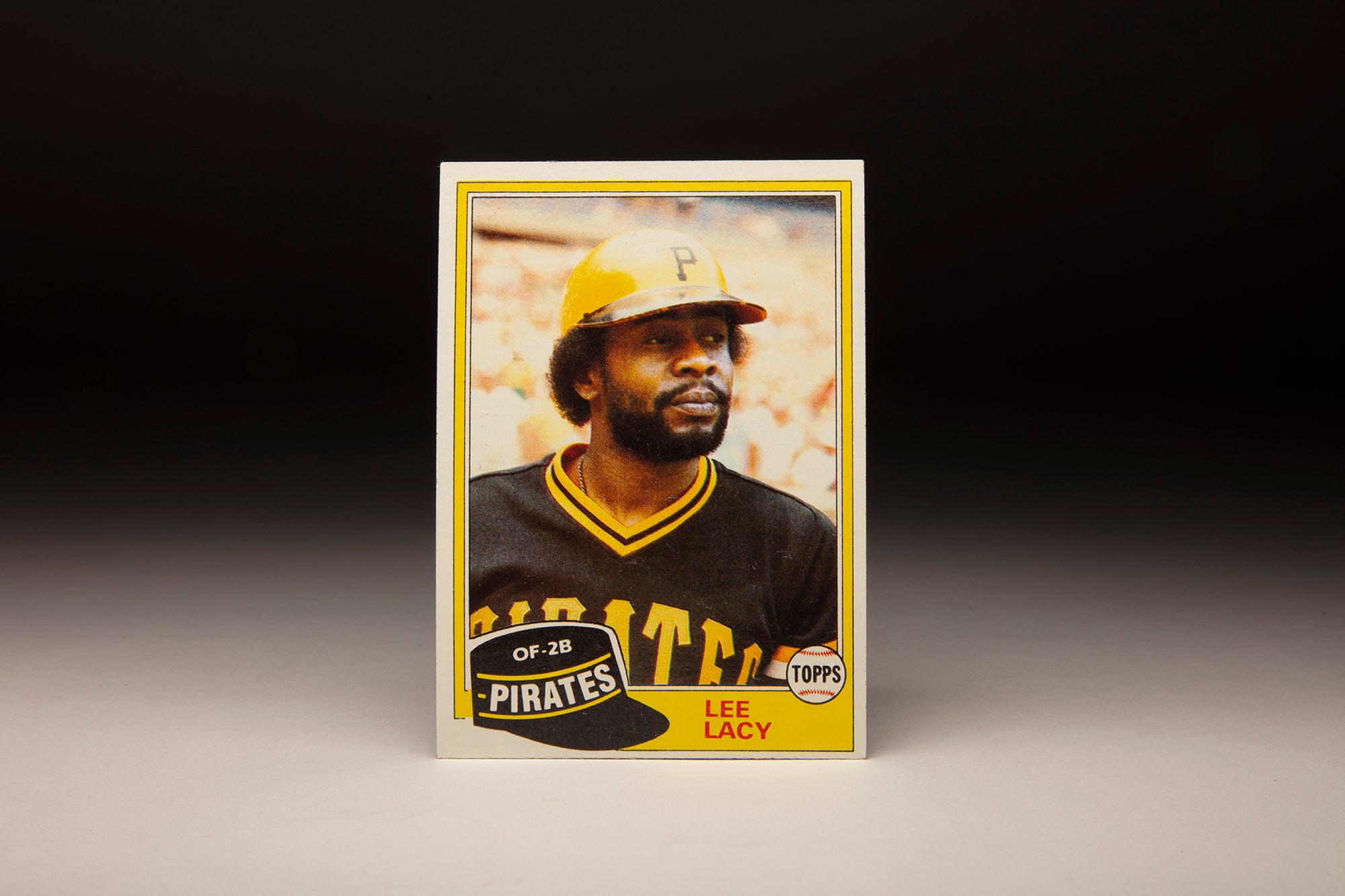
#CardCorner: 1981 Topps Lee Lacy

#CardCorner: 1981 Topps Ken Landreaux
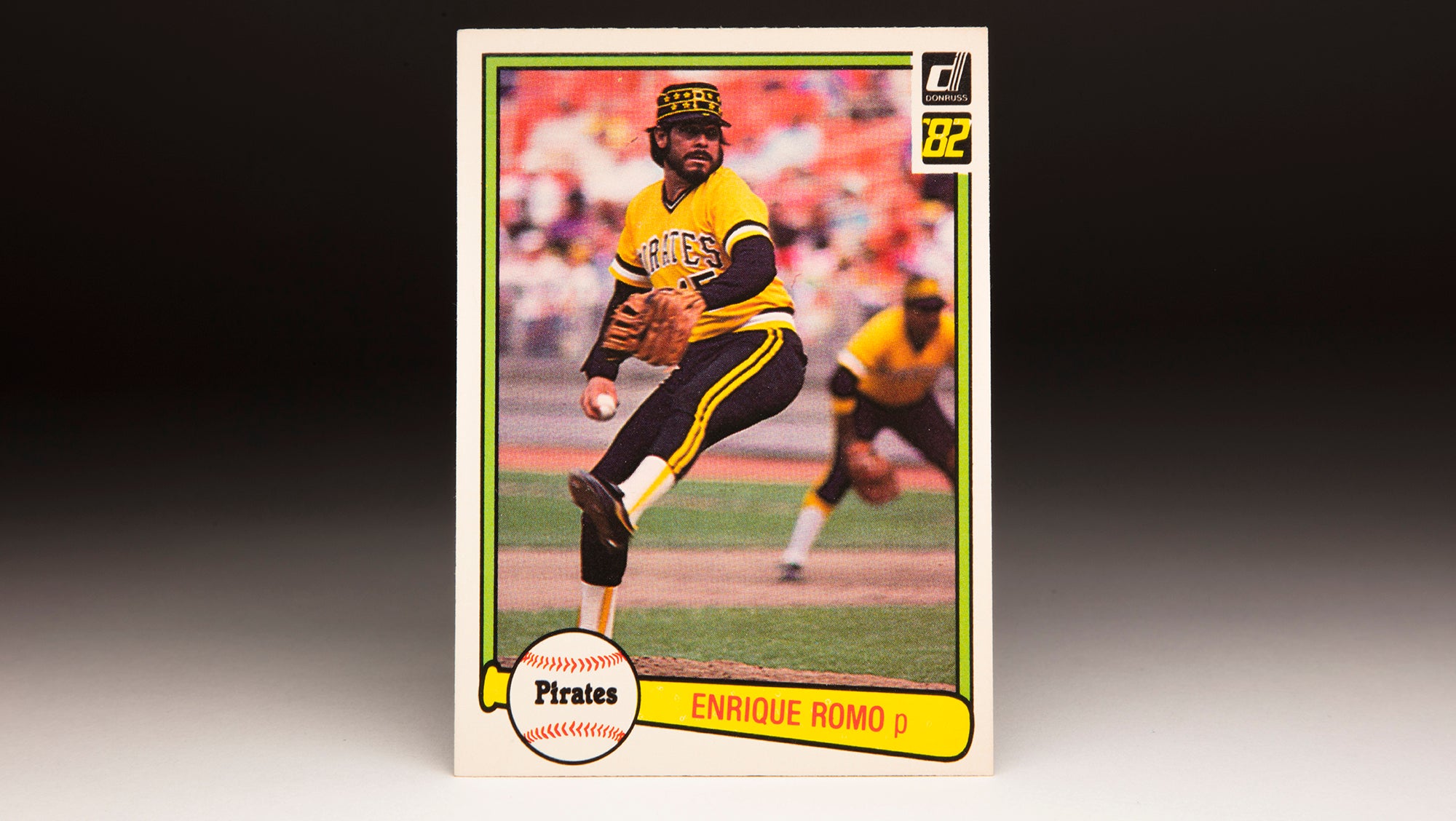
#CardCorner: 1982 Donruss Enrique Romo
Related Stories

#CardCorner: 1981 Topps Lee Lacy

#CardCorner: 1981 Topps Ken Landreaux



